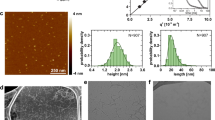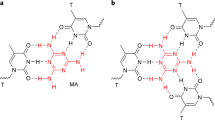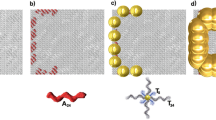Abstract
The double-helix structure of DNA, in which complementary strands reversibly hybridize to each other, not only explains how genetic information is stored and replicated, but also has proved very attractive for the development of nanomaterials. The discovery of metal-mediated base pairs has prompted the generation of short metal–DNA hybrid duplexes by a bottom-up approach. Here we describe a metallo-DNA nanowire—whose structure was solved by high-resolution X-ray crystallography—that consists of dodecamer duplexes held together by four different metal-mediated base pairs (the previously observed C–Ag–C, as well as G–Ag–G, G–Ag–C and T–Ag–T) and linked to each other through G overhangs involved in interduplex G–Ag–G. The resulting hybrid nanowires are 2 nm wide with a length of the order of micrometres to millimetres, and hold the silver ions in uninterrupted one-dimensional arrays along the DNA helical axis. The hybrid nanowires are further assembled into three-dimensional lattices by interactions between adenine residues, fully bulged out of the double helix.
This is a preview of subscription content, access via your institution
Access options
Access Nature and 54 other Nature Portfolio journals
Get Nature+, our best-value online-access subscription
$29.99 / 30 days
cancel any time
Subscribe to this journal
Receive 12 print issues and online access
$259.00 per year
only $21.58 per issue
Buy this article
- Purchase on Springer Link
- Instant access to full article PDF
Prices may be subject to local taxes which are calculated during checkout




Similar content being viewed by others
References
Watson, J. D. & Crick, F. H. C. A structure for deoxyribose nucleic acid. Nature 171, 737–738 (1953).
Neidle, S. Principles of Nucleic Acid Structure (Academic, 2007).
Sunami, T. et al. Crystal structure of d(GCGAAAGCT) containing a parallel-stranded duplex with homo base pairs and an anti-parallel duplex with Watson–Crick base pairs. Nucleic Acids Res. 30, 5253–5260 (2002).
Kondo, J., Adachi, W., Umeda, S., Sunami, T. & Takénaka, A. Crystal structures of a DNA octaplex with I-motif of G-quartets and its splitting into two quadruplexes suggest a folding mechanism of eight tandem repeats. Nucleic Acids Res. 32, 2541–2549 (2004).
Seeman, N. C. Structural DNA Nanotechnology (Cambridge Univ. Press, 2016).
Gao, K. & Orgel, L. E. Nucleic acid duplexes incorporating a dissociable covalent base pair. Proc. Natl Acad. Sci. USA 96, 14837–14842 (1999).
Li, H.-Y., Q. Y.-L., Moyroud, E. & Kishi, Y. Synthesis of DNA oligomers possessing a covalently cross-linked Watson–Crick base pair model. Angew. Chem. Int. Ed. 40, 1471–1475 (2001).
Hatano, A., Makita, S. & Kirihara, M. Synthesis and characterization of a DNA analogue stabilized by mercapto C-nucleoside induced disulfide bonding. Bioorg. Med. Chem. Lett. 14, 2459–2462 (2004).
Schweitzer, B. A. & Kool, E. T. Hydrophobic, non-hydrogen-bonding bases and base pairs in DNA. J. Am. Chem. Soc. 117, 1863–1872 (1995).
Hirao, I. et al. An unnatural hydrophobic base pair system: site-specific incorporation of nucleotide analogs into DNA and RNA. Nat. Methods 3, 729–735 (2006).
Malyshev, D. A. & Romesberg, F. E. The expanded genetic alphabet. Angew. Chem. Int. Ed. 54, 11930–11944 (2015).
Clever, G. H., Kaul, C. & Carell, T. DNA–metal base pairs. Angew. Chem. Int. Ed. 46, 6226–6236 (2007).
Ono, A., Torigoe, H., Tanaka, Y. & Okamoto, I. Binding of metal ions by pyrimidine base pairs in DNA duplexes. Chem. Soc. Rev. 40, 5855–5866 (2011).
Takezawa, Y. & Shionoya, M. Metal-mediated DNA base pairing: alternatives to hydrogen-bonded Watson–Crick base pairs. Acc. Chem. Res. 45, 2066–2076 (2012).
Scharf, P. & Müller, J. Nucleic acids with metal-mediated base pairs and their applications. ChemPlusChem 78, 20–34 (2013).
Tanaka, Y. et al. Structures, physicochemical properties, and applications of T–Hg(II)–T, C–Ag(I)–C, and other metallo-base-pairs. Chem. Commun. 51, 17343–17360 (2015).
Ono, A. & Togashi, H. Highly selective oligonucleotide-based sensor for mercury(II) in aqueous solutions. Angew. Chem. Int. Ed. 43, 4300–4302 (2004).
Ono, A. et al. Specific interactions between silver(I) ions and cytosine–cytosine pairs in DNA duplexes. Chem. Commun. 51, 4825–4827 (2008).
Müller, J. Chemistry: metals line up for DNA. Nature 444, 698 (2006).
Liu, S. et al. Direct conductance measurement of individual metallo-DNA duplexes within single-molecule break junctions. Angew. Chem. Int. Ed. 50, 8886–8890 (2011).
Ehrenschwender, T. et al. Development of a metal-ion-mediated base pair for electron transfer in DNA. Chem. Eur. J. 19, 12547–12552 (2013).
Tanaka, K. et al. Programmable self-assembly of metal ions inside artificial DNA duplexes. Nat. Nanotechnol. 1, 190–194 (2006).
Clever, G. H. & Carell, T. Controlled stacking of 10 transition-metal ions inside a DNA duplex. Angew. Chem. Int. Ed. 46, 250–253 (2007).
Schmidbaur, H. & Schier, A. Argentophilic interactions. Angew. Chem. Int. Ed. 54, 746–784 (2015).
Atoji, M., Richardson, J. W. & Rundle, R. E. On the crystal structures of the magnus salts, Pt(NH3)4PtCl4 . J. Am. Chem. Soc. 79, 3017–3020 (1957).
Blake, A. J., Champness, N. R., Chung, S. S. M., Li, W. S. & Schroder, M. In situ ligand synthesis and construction of an unprecedented three-dimensional array with silver(I): a new approach to inorganic crystal engineering. Chem. Commun. 1675–1676 (1997).
Chen, C. Y., Zeng, J. Y. & Lee, H. M. Argentophilic interaction and anionic control of supramolecular structures in simple silver pyridine complexes. Inorg. Chim. Acta 360, 21–30 (2007).
Kondo, J. et al. High-resolution crystal structure of a silver(I)–RNA hybrid duplex containing Watson–Crick-like C–silver(I)–C metallo-base pairs. Angew. Chem. Int. Ed. 54, 13323–13326 (2015).
Ennifar, E., Walter, P. & Dumas, P. A crystallographic study of the binding of 13 metal ions to two related RNA duplexes. Nucleic Acids Res. 31, 2671–2682 (2003).
Kondo, J. et al. Crystal structure of metallo DNA duplex containing consecutive Watson–Crick-like T–Hg(II)–T base pairs. Angew. Chem. Int. Ed. 53, 2385–2388 (2014).
Yamaguchi, H. et al. The structure of metallo-DNA with consecutive thymine–HgII–thymine base pairs explains positive entropy for the metallo base pair formation. Nucleic Acids Res. 42, 4094–4099 (2014).
Bondi, A. Van der Waals volumes and radii. J. Phys. Chem. 68, 441–451 (1964).
Wells, A. F. Structural Inorganic Chemistry 5th edn (Clarendon, 1984).
Johannsen, S., Megger, N., Böhme, D., Sigel, R. K. O. & Müller, J. Solution structure of a DNA double helix with consecutive metal-mediated base pairs. Nat. Chem. 2, 229–234 (2010).
Kumbhar, S., Johannsen, S., Sigel, R. K. O., Waller, M. P. & Müller, J. A QM/MM refinement of an experimental DNA structure with metal-mediated base pairs. J. Inorg. Biochem. 127, 203–210 (2013).
Dairaku, T. et al. Structure determination of an AgI-mediated cytosine–cytosine base pair within DNA duplex in solution with 1H/15N/109Ag NMR spectroscopy. Chem. Eur. J. 22, 13028–13031 (2016).
Palmans, R., MacQueen, D. B., Pierpont, C. G. & Frank, A. J. Synthesis and characterization of bis(2,2′-bipyridyl)platinum(I): a novel microtubular linear-chain complex. J. Am. Chem. Soc. 118, 12647–12653 (1996).
Kiguchi, M. et al. Highly conductive [3 × n] gold-ion clusters enclosed within self-assembled cages. Angew. Chem. Int. Ed. 52, 6202–6205 (2013).
Kabsch, W. XDS. Acta Crystallogr. D 66, 125–132 (2010).
Adams, P. D. et al. PHENIX: a comprehensive python-based system for macromolecular structure solution. Acta Crystallogr. D 66, 213–221 (2010).
Grosse-Kunstleve, R. W. & Adams, P. D. Substructure search procedures for macromolecular structures. Acta Crystallogr. D 59, 1966–1973 (2003).
Terwilliger, T. C. et al. Decision-making in structure solution using Bayesian estimates of map quality: the PHENIX AutoSol wizard. Acta Crystallogr. D 65, 582–601 (2009).
Emsley, P. & Cowtan, K. Coot: model-building tools for molecular graphics. Acta Crystallogr. D 60, 2126–2162 (2002).
Emsley, P., Lohkamp, B., Scott, W. G. & Cowtan, K. Features and development of Coot. Acta Crystallogr. D 66, 486–501 (2010).
Afonine, P. V. et al. Towards automated crystallographic structure refinement with Phenix.refine. Acta Crystallogr. D 68, 352–367 (2012).
Olson, W. K. et al. A standard reference frame for the description of nucleic acid base-pair geometry. J. Mol. Biol. 313, 229–237 (2001).
Lu, X. J. & Olson, W. K. 3DNA: a software package for the analysis, rebuilding and visualization of three-dimensional nucleic acid structures. Nucleic Acids Res. 31, 5108–5121 (2003).
Acknowledgements
This work was supported by a Grant-in-Aid for Scientific Research (A) (No. 24245037) and in part by a Strategic Research Foundation Grant-aided Project for Private Universities (No. S1201015) from the Ministry of Education, Culture, Sports, Science and Technology, Japan. J.K. was also supported by the Murata Science Foundation. We thank the Photon Factory for the provision of synchrotron radiation facilities (No. 2013G727, 2015G533). We acknowledge Y. Matsuda at the Tokushima Bunri University for sample preparation.
Author information
Authors and Affiliations
Contributions
J.K., A.O. and Y.Tan. supervised the project. Y.Tad. and J.K. solved the crystal structure. T.D., Y.H. and Y.Tan. performed the NMR analyses. H.S. synthesized the oligonucleotides and performed preliminary experiments. All the authors contributed to discussions.
Corresponding author
Ethics declarations
Competing interests
The authors declare no competing financial interests.
Supplementary information
Supplementary information
Supplementary information (PDF 1049 kb)
Rights and permissions
About this article
Cite this article
Kondo, J., Tada, Y., Dairaku, T. et al. A metallo-DNA nanowire with uninterrupted one-dimensional silver array. Nature Chem 9, 956–960 (2017). https://doi.org/10.1038/nchem.2808
Received:
Accepted:
Published:
Issue Date:
DOI: https://doi.org/10.1038/nchem.2808
This article is cited by
-
A Bifunctional-Blocker-Aided Hybridization Chain Reaction Lighting-Up Self-calibrating Nanocluster Fluorescence for Reliable Nucleic Acid Detection
Journal of Analysis and Testing (2024)
-
6-Pyrazolylpurine and its deaza derivatives as nucleobases for silver(I)-mediated base pairing with pyrimidines
JBIC Journal of Biological Inorganic Chemistry (2023)
-
“Metal-modified base pairs” vs. “metal-mediated pairs of bases”: not just a semantic issue!
JBIC Journal of Biological Inorganic Chemistry (2022)
-
A dissipative pathway for the structural evolution of DNA fibres
Nature Chemistry (2021)
-
Core engineering of paired core-shell silver nanoclusters
Science China Chemistry (2021)



